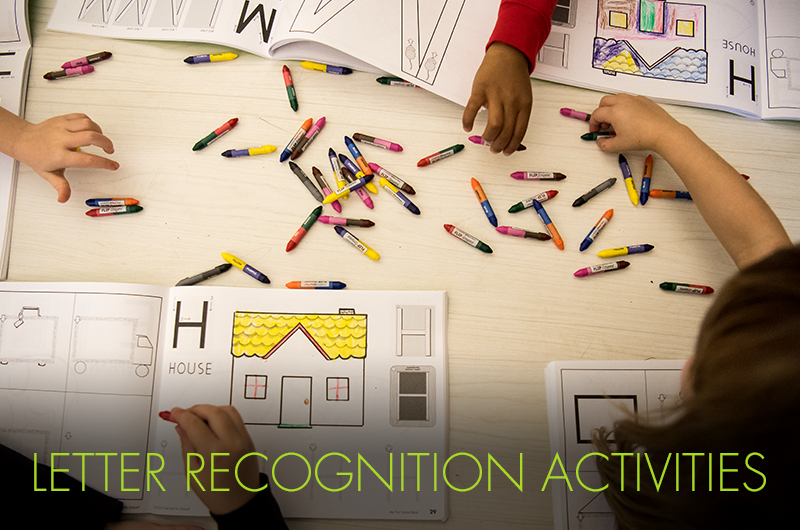4 Letter Recognition Activities for Preschoolers


Preschool is a time of significant cognitive skill development. One of the foundational skills that is important for future academic success is letter recognition.
What Is Letter Recognition?
In our Get Set For School curriculum, we define Alphabet Knowledge, or Letter Recognition, as the ability to name the letters of the alphabet and recognize letters in print. This is everything about letters that isn’t writing. It’s singing, speaking, matching, sorting, and naming. It is also one of the most accurate predictors of early reading success (Johnston 2004).
Research shows that letter recognition is enhanced by writing letters in preschool (Fancher, Priestley-Hopkins, & Jeffries, 2018; Li & James, 2016). In fact, handwriting letters is further enhanced by completing activities with various fonts of letters (Li & James, 2016).
How to Teach Letter Identification
Many letter recognition activities can be done at school, home, and in various other environments. However, it is important to engage your child in the activities.
- They should be fun and interesting to help motivate the child to participate.
- These activities are not dependent on the child’s ability to hold or manage a writing tool.
- They’re still active and hands-on. Many of these activities have a social component as children recognize letters in their names and in the names of other people in their lives.
- When introducing writing, paper and pencil improves letter recognition more than using a stylus on a screen or typing letters on a keyboard (Mayer, C., Wallner, S., Budde-Spengler, N., Braunert, S., Arndt, P. A., & Kiefer, M. 2020).
- However, many children are motivated by digital activities, so it is important to balance digital activities and non-screen activities when addressing letter recognition of preschool children.
Fun Preschool Letter Recognition Activities
Find Letters
- Point out letters around the home and in the child’s environment and you and the child say the names of them together (keyboard at home, magnetic letters on the refrigerator, letters on signs, puzzles, storybooks).
- Make this an independent activity by hiding letters around the house for your children to find. Check out this video by my fellow presenter, Katrina Erickson for details.
Letter Fun (Pre-K)
Katrina Erickson, OTR talks about having letter fun with young learners.
Posted by Learning Without Tears on Tuesday, May 12, 2020
Match Letters
- Work on matching letters. First match the same case letters (i.e., match K with K). Then progress to matching capital to lowercase (i.e., match K with k). You can use our A-B-C Touch and Flip® cards for a multisensory experience or Make Your Own Letter Cards.
Build Letters
- Build letters with various items from a demonstration and example (popsicle sticks, pipe cleaners, Wikki Stix, Wood Pieces for Capital Letters, and moldable dough).
Handwriting-based Activities to Increase Letter Recognition
Make sure the child has an example of the letter to see when completing writing alphabet activities. They should not be expected to do them from memory.
Trace and Copy
Teach the child how to trace and copy letters (capitals are easier than lowercase).
- Use a variety of writing tools (crayons, chalk, colored pencils, markers) and colors when tracing and copying to increase motivation to participate.
- Small tools are easier to hold and move around than large ones. Some of my favorite tools are FLIP Crayons® and Little Chalk Bits, designed specifically for little hands.
- Use fingers in various substances to trace letters (substances such as shaving cream, rice, sand, foam soap in the bathtub). I love this examples using colored salt.
- Our Wet-Dry-Try activity is another great multisensory way to introduce handwriting.
- Participte in digital letter formation activities in moderation (i.e., Wet-Dry-Try App https://wetdrytry.com/). It is important that you ensure the digital activity includes a demonstration and does not allow the child to start in the wrong place or complete the strokes in the wrong order, or it could reinforce negative habits instead of teaching good ones.
Letter Recognition Is Easy with Learning Without Tears!
Letter recognition activities do not have to take a lot of time or be difficult to prepare. The important thing is to incorporate them often throughout the day and week to continue to build letter recognition skills and enhance literacy skills in elementary school.
At Learning Without Tears, the activities found within our Pre-K curriculum, Get Set For School, address the broad range of alphabet experiences and knowledge in your classroom. Click here to learn more.
References
- Fancher, L. A., Priestley-Hopkins, D. A., & Jeffries, L. M. (2018) Handwriting Acquisition and Intervention: A Systematic Review. Journal of Occupational Therapy, Schools, & Early Intervention, 11(4), 454-473, http://dx.doi.org/10.1080/19411243.2018.1534634
- Johnston, F.R. (2004) “Phonics, Phonological Awareness, and the Alphabet.” EPS Update, April. http://eps.schoolspeciality.com/downloads/articles/phonological.awarenes....
- Li, J. X. & James, K. H. (2016) Handwriting generates variable visible output to facilitate symbol learning. Journal of Experimental Psychology: General, 145(3), 298-313. http://dx.doi.org/10.1037/xge0000134
- Mayer, C., Wallner, S., Budde-Spengler, N., Braunert, S, Arndt, P. A., & Kiefer, M. (2020) Literacy training of kindergarten children with pencil, keyboard or tablet stylus: the influence of the writing tool on reading and writing performance at the letter and word level. Frontiers in Psychology, NA. Retrieved from https://link.gale.com/apps/doc/A611995353/HRCA?u=ncliveecu&sid=HRCA&xid=...


